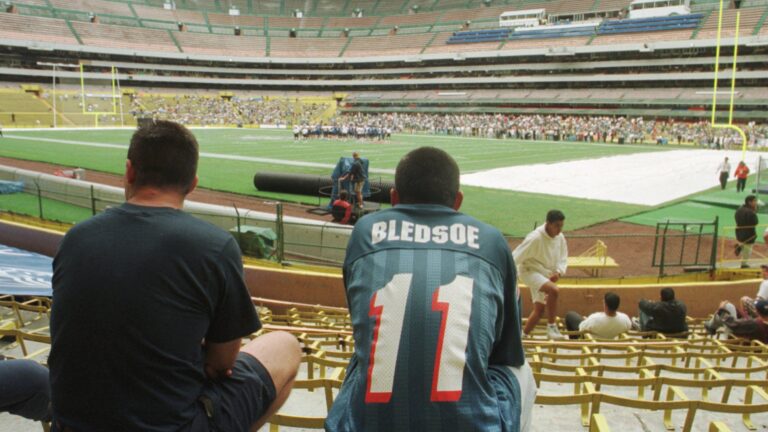At Estadio Azteca, the Patriots will play on one of football’s hallowed grounds

On Sunday, the Patriots take the field in Mexico City in one of the most unique and storied sports venues in the world. Estadio Azteca, the largest stadium in Mexico, has been the stage for some of the greatest football ever played (though not the kind Tom Brady and the Patriots are used to).
The venue has hosted its share of NFL games over the years. In fact, this will actually not be the Patriots’ first visit to Mexico City or Azteca – they defeated the Cowboys, 21-3, in a 1998 preseason game in front of more than 106,000.
Despite the earthquake that struck Mexico City in September, the stadium held up “remarkably well’’ and passed safety inspections. Tickets sold at a rapid rate, testament to the game’s popularity in Mexico.
The Patriots have been preparing at the Air Force Academy in Colorado following last week’s game against the Broncos in Denver. The decision to stay at higher altitude was naturally not an accident.
One of the defining characteristics of Azteca is its altitude – at 7,200 feet above sea level, it is higher in elevation than the summit of New England’s tallest peak, Mount Washington (6,288 feet).
Though it’s not the highest elevation in the world for a major stadium (Bolivia’s Estadio Hernando Siles holds that distinction), its effect on visitors unaccustomed to the altitude can be profound.

Drew Bledsoe meets the press in the vastness of Estadio Azteca prior to a 1998 preseason game against the Cowboys.
“You start dealing with the heat and the altitude, and it gets into your head,’’ former US men’s soccer coach Bruce Arena once told the New York Times. “Not only your head — the physiology is difficult.’’
The atmosphere inside the stadium (with a modern capacity of 87,000) is also the stuff of legend. For visiting teams playing Mexico’s national soccer team, it’s an intimidating experience. Players describe the crowd making a buzzing sound when the opposition has the ball, so as to make it seem like a giant “beehive.’’
“When you get to the field and look up, it’s just a massive wall of human beings and concrete,’’ U.S. goalkeeper Brad Guzan once wrote in The Players’ Tribune about Azteca. “It almost feels like the stands are completely vertical. There’s no real ‘slant’ to the upper bowls like there is with modern stadiums. You can’t even see the sky.’’
“It’s like the cathedral of Mexican football,’’ said retired national team great Claudio Suarez.
As important a place as Azteca is for Mexican soccer, it’s also been a world stage on multiple occasions. In 1970, Mexico was the site of Pelé’s last World Cup, and Azteca helped provide the Brazilian team a priceless soccer advantage: time and space.
Aided by the altitude, which prevented some of the more physical European opponents from applying the labor-intensive systemic pressure that has since become the standard style, Brazilian players were free to show off their brilliance. It was, as historians have noted, the last ember of a dying ideal of soccer romanticism. Players, not systems, won the 1970 World Cup for Brazil. And it was the last time such an informal tactical approach prevailed.
Nothing epitomized the ideal more than the 1970 final, played in front of an Azteca crowd numbering 107,412. Brazil, purveyors of “Jogo Bonito’’ (“The Beautiful Game’’) faced Italy, the ultimate masters of defense. Pelé scored Brazil’s first goal, and provided the assist on one of the greatest team goals in World Cup history:
[fragment number=0]
Brazil triumphed 4-1, leveraging Azteca’s conditions to provide an enduring legacy of attacking soccer.
Mexico was chosen to host the World Cup again only 16 years later, and became the first stadium to host multiple World Cup finals.
The 1986 tournament provided the setting for another South American legend: Argentina’s Diego Maradona, who played his best soccer there. Facing England in the quarterfinal, Maradona was the difference between the two teams. He scored one of the most infamous goals in history (the “Hand of God’’), but also electrified the crowd with what was later dubbed “the Goal of the Century.’’
[fragment number=1]
Argentina won 2-1, and went on to beat West Germany in the final (played once again in Azteca), 3-2.
Aside from soccer, Azteca has also been the setting for several notable NFL games. In 1994, a preseason game between the Houston Oilers and Dallas Cowboys set the record for highest attendance at any NFL game in history (112,376).
It was also the site of the league’s first international regular season game, when the San Francisco 49ers beat the Arizona Cardinals in 2005.







